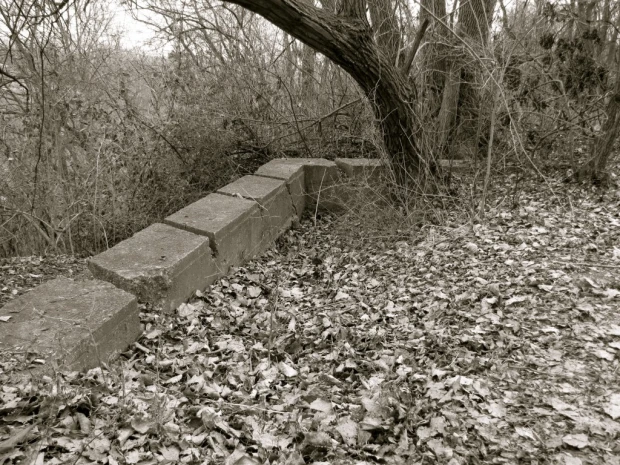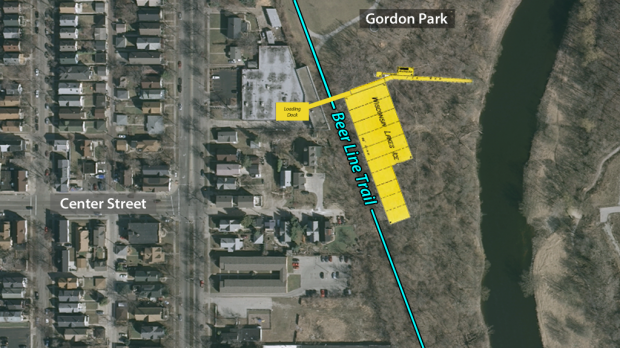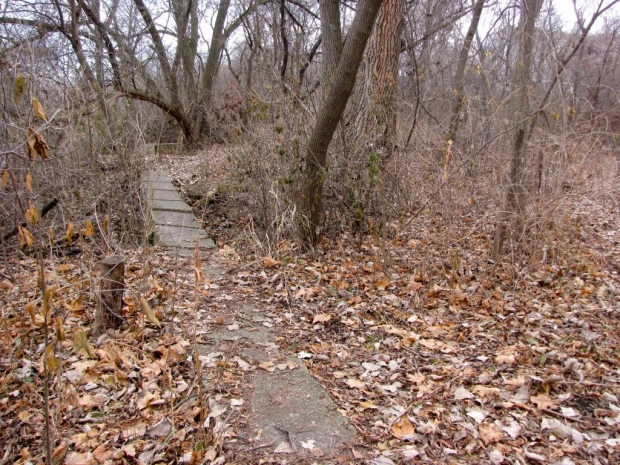
This concrete foundation, atop a river bluff south of Gordon Park, was part of the Wisconsin Lakes Ice & Cartage Company’s Center Street icehouse, destroyed in a massive fire a century ago. Carl Swanson photo
A concrete foundation in the woods south of Gordon Park in Milwaukee’s Riverwest neighborhood is all that remains of the Wisconsin Lakes Ice & Cartage Co. Center Street icehouse. The 350 x 100-foot icehouse, built in the late 1800s alongside the Chicago, Milwaukee & St. Paul RR’s “Beer Line,” was one of several icehouses on the upper Milwaukee River. The icehouse burned to the ground in a spectacular multi-alarm fire in June 1911.

Wisconsin Lakes Ice & Cartage Co. operated several Milwaukee River icehouses in the late 1800s to early 1900s, including a five-story-high 350 x 100-foot structure at the foot of Center Street in Riverwest. It is shown in yellow in this illustration. Illustration by Carl Swanson
The icehouse’s trackside location simplified shipping. A long, inclined ramp extended down the steep bluff to the river’s edge. In winter, teams of men would harvest blocks of ice, which were carried up the bluff on a conveyor. The ice was stored for use in the warm months in the days before mechanical refrigeration.
Wisconsin Lakes was the largest ice dealer in town. It supplied both homes and businesses. The firm was also one of the combatants in the infamous “Ice War” of 1901, a multi-day full-scale brawl on the frozen Milwaukee River.
The company’s Center Street icehouse was a hollow wooden box five stories tall. It sold ice to wholesalers and the brewing industry. At the time of the fire, the building contained 35,000 tons of ice arranged in layers and insulated by blankets of sawdust.
On June 7th, 1911, canoeists on the Milwaukee River spotted flames at the south end of the structure and alerted the fire department. The building was an inferno by the time the first engine company arrived. So intense was the heat, the Milwaukee Sentinel reported, rubber coats melted on the backs of the firefighters.
The coat of one firefighter, Lt. John Doyle, burst into flames. His own men saved his life by turning a fire hose on him but Doyle suffered serious burns to both his hands.
The blaze attracted a large crowd, some of whom narrowly escaped injury themselves according to the Sentinel: “Shortly after 4 o’clock, the east wall of the burning building came down, carrying several hundred tons of ice down the hill, and into the river. The crowds of people lined along the river had to scramble out of the way in a hurry, several falling into the water in their haste.”
President John H. Kopmeier of Wisconsin Lakes Ice & Cartage Co. estimated the loss at $65,000 (equal to $1.6 million today). The icehouse was not insured. This was the third fire the company suffered in as many years, having previously lost icehouses at Silver Spring and on Oklahoma Avenue.
The company said it believed sparks from a passing steam locomotive started the fire. There were six employees at work in the icehouse when the fire started. All escaped safely and were certain the fire had not started inside the building.
The Center Street icehouse was not rebuilt and only its foundation remains, deep in the woods east of the Beer Line Trail.
Carl Swanson is the author of the book Lost Milwaukee from The History Press, available from book stores or online.

I wonder about “beer-centric” Milwaukee during Prohibition…
LikeLike
There’s more history down there than you know. South of this icehouse but before Clark street is a poured concrete curved structure that seems to have possibly been a pedestrian bridge over the river. Farther south from wright street at the bottom of the bank are quite a few concrete pads, remnants of what our folks said where testing areas/ buildings for an outboard motor company to test their products on the river. You’ve only scratched the surface though, there’s more down there.
Thanks for your informative articles?
LikeLike
There’s always more to learn. Thank you for pointing me to some new things to check out. Who knows? Maybe they’ll become a blog post!
LikeLike
I love these posts!
LikeLike